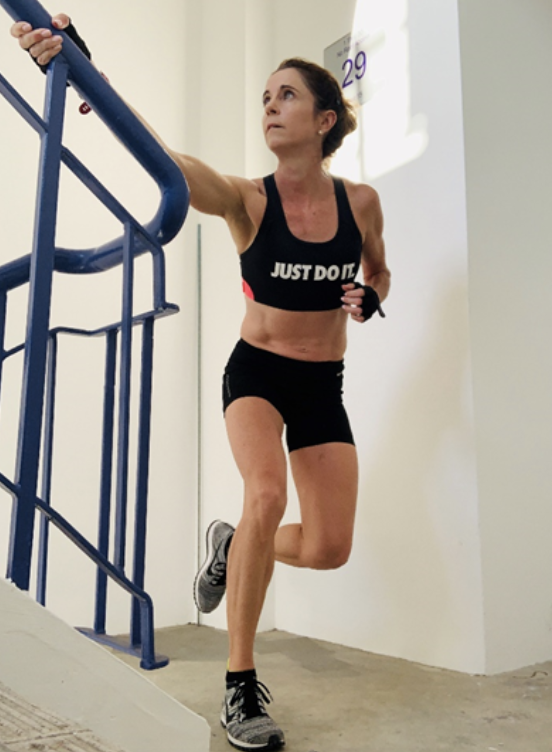Who Is Suzy?
Starting racing competitively at just 7 years old, Suzy is no stranger to training hard and racing at an elite level. From a running career including successes such as placing 6th in the 2006 Commonwealth Games 1500m and several Australian national open titles over 800m and 1500m, Suzy then moved to stair racing when she relocated to Singapore in 2006. She has dominated the worldwide stair racing circuits for the last decade and is the 9 times Tower Running World Cup winner and a 10 times winner of the Empire State Building Run Up. Suzy’s personal journey has shown her just how important strength training is for both her performance and her health and she has been kind enough to share her story with us! You don’t want to miss out on reading this one.
Why Weight Training Is The Most Important Thing I Do.
When it comes to weight/strength training, the image that often springs to mind is that of professional weightlifters and body-builders, with their big, bulky, bulging muscles. As a female and a distance athlete, not only do I not really want to look like that, but the weight and bulk of such big muscles would only slow me down. Does that mean I avoid the gym? Absolutely not, because there’s a whole lot of benefits strength and weight training provides for athletes (and non-athletes!) of all abilities and disciplines and it’s an integral part of my regular training program.
What is strength training?
Strength training doesn’t only include all those racks, dumbbells, and weight machines you see at the gym. Strength training – also known as weight or resistance training – includes everything from free weights, weight machines, medicine balls, resistance bands, and even your own body weight, basically anything that improves your muscular fitness by exercising a specific muscle or muscle group through external resistance.
Many people (especially women) focus primarily on cardio and aerobic training, thinking that’s the best and only way to stay in shape, but by excluding or doing minimal strength training, they are missing out on a whole host of benefits including:
Protecting bone health
Building strength and fitness
Improving efficiency through better body mechanics
Reducing fat and speeding up metabolism
I was introduced to strength training in the early 1990’s while at the Australian Institute of Sport on a Track and Field scholarship (I competed in 800m and 1500m). It was incorporated into my training then, but I had some difficult years in my late teens and early twenties with a lot of bone related injuries (more on that later!) and stopped competing and didn’t train much for about 5 years. I returned to competition in 1999 and regular weight training has been an important part of my training since.
Bone Health
Protecting my bone health is probably the most critical reason I do my weight training. Most people reach their peak bone mass between the ages of 25 and 30, but from the age of 30, your body doesn’t build bone as readily as it used to, and after age 40, you can lose 1% of your bone mass every year!
In my late teens and early 20’s I suffered from the dreaded female athlete triad – a medical condition involving 3 components – low energy availability with or without disordered eating, menstrual dysfunction (amenorrhea) and low bone density. Even though at the time I was not dieting or training excessively (running 40-50km per week), my body just wasn’t coping. By my late 20’s I was told I had the bone density of a post-menopausal women, quite a daunting diagnosis when it was supposed to be the time my bone density was near its highest. Aged 32, I raced my last track races at the 2006 Commonwealth Games knowing I was getting a stress fracture – this became my 14th stress fracture and was so bad by the time I had it scanned, that the bone (tibia) was fractured 1/3 of the way through – my scans were the kind of scans sports doctors asked to show their students!
So for the last 14 years, I’ve been working on maintaining what bone density I have, and strength training is crucial for that. Studies have shown that strength training, performed two to three times per week, preserves or even increases bone mineral density in middle-aged, post-menopausal and older populations. This is due to the “stress” put on bones from the repetitive loading which leads to the release of growth factors that stimulate the growth of bones and connective tissues. For me, testing has shown I have not lost any bone mineral density in the last 12 years, even though theoretically I could have lost 5%+. I still have slight osteopenia (diminished bone density) in my spine, but my dot on the graph is moving closer to the “normal” band, and that stress fracture in 2006 has so far been my last.
Building strength
It’s a no-brainer that strength training is going to make your muscles stronger and therefore improve your performance, but it also results in muscles and tendons that are more resilient to the stresses and impact forces of training and racing, thereby reducing the risk of injury. Like your bones, age-related muscle loss starts occurring from age 30, and can reduce by 3-5% per decade, so as an aging athlete, I’m trying to minimize this muscle loss as much as possible.
To get the most out of your strength training, your program should be sport-specific – that is, it should focus on the muscle groups you rely on most in your chosen sport. As a runner/stair runner, I’m focused on moving forward and being balanced so my strength training incorporates typical lower body exercises (ie squats, lunges, bridges and leg curls, side leg raises, etc) and core work. I also throw in some arm exercises because strong arms can help with your balance and drive forward when you run, and it’s useful when I’m yanking on that the handrail as I climb the stairs…..plus, as a middle-aged mum, I think it’s kind of cool to be able to do pull-ups!
Improving efficiency, balance and mobility
Running isn’t easy, but strength training can improve your running efficiency by encouraging better coordination and stride efficiency and giving you more power and agility. Because your muscles are stronger, they don’t tire as easily, so you are able to maintain better form for longer. This will help you to not only run faster, but also reduce the risk of injury as your muscles are better able to handle the stress.
Full range strength training that incorporates both concentric (the raising phase which shortens the muscle) and eccentric (lowering phase which lengthens the muscle) functions will benefit your mobility and flexibility. Many people incorrectly think that doing weights adds bulk and stiffness, but when performed correctly, working your joints through their full range of motion can actually improve your flexibility.
If you’re a runner, or incorporating running into your training, it’s worthwhile to get your running biomechanics assessed, as this will pick up weaknesses/poor form that specific strengthening exercises can help fix. Similarly, if you are recovering from injury, your physio/sports doctor should be giving you exercises to strengthen the areas that were injured or caused the injury, to minimise the risk of recurrence. I’m currently working on strengthening my right calf which lost a lot of muscle bulk/strength after I tore it, as well as some foot exercises to help strengthen and improve mobility in my rigid, high-arch feet.
Reducing fat and speeding up metabolism
While this benefit is not as important to me as some of the others, as an athlete, I want to be lean and strong, and maintain my current weight without too much effort. Many people wrongly think the only way to lose weight and get lean, is to burn as many calories as possible from a session. But did you know that weight training can create more lean muscle, thereby helping your body to burn more calories every day? Your muscle mass largely determines your resting metabolic rate (how many calories your body burns from just operating) so by increasing your muscle mass, you’ll also increase the number of calories your body naturally burns in a day.
An important point to make here is that while weight training will make you leaner and speed up your metabolism, it might not always show on the scales. Muscle weighs more than fat, but takes up less space, so if you are looking to get leaner from your weight training, focus more on how your clothes fit rather than the number on the scales.
How do I get started?
If you’ve never done strength or weight training before it can be a bit daunting arriving at the gym with the myriad of machines, free weights, balls and equipment. Similarly, if you’re in a bit of a training rut or have been doing the same routine for years and no longer seeing improvement, its possibly time to change things up a bit.
My suggestion is to first find an accredited personal trainer or strength and conditioning coach who can get you started on a routine that is geared towards your ability, sport and goals. And it doesn’t necessarily have to start in a gym! Using your body weight through a range of exercises is still extremely beneficial, especially as a starting point. I incorporate both actual weights and body weight exercises in my training and I find the mix works well for me.
While my strength training regime is currently geared towards helping me in my sport and maintaining my bone health, the vast, proven general health benefits of it will see me continue this kind of training long after I am no longer competing.








